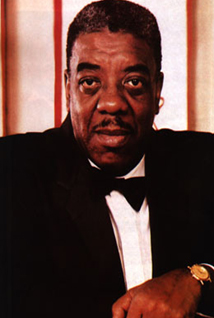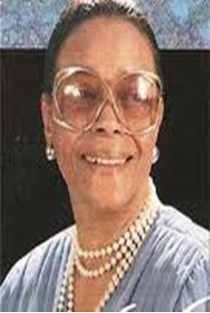Cultural Resources
CHOIR ANNIVERSARY
CULTURAL RESOURCES
Sunday, August 21, 2011
Tammy L. Kernodle, Guest Cultural Resources Commentator
Miami University, Associate Professor of Musicology
I. The History Section
Since the first gospel choir appeared in the 1930s at the Pilgrim Baptist Church in Chicago, it has remained one of the most recognized symbols of Black Church culture and Christendom in general. In the decades since Thomas Dorsey, Theodore Frye, Lucie Campbell, and several other individuals advanced the gospel choir as one of the significant agents of worship, the nature of music ministry has evolved extensively. Today many congregations have multiple choirs that are defined by age and gender as well as by the type of repertoire performed. Despite diverse and sometimes controversial ideologies about the role of the choir within the Church and the appropriateness of certain types of music within the context of worship, the one unifying agent that draws all of these phenomenon together is the celebration of Choir Day or the Choir Anniversary. This celebration, outside of the annual concerts or musical programs, is one of the few moments within the life of the Black Church in which the importance of the ministry of music in the life of the Church and its role in extending the ministry of the Word is acknowledged.
The history of the choir within black congregations is intertwined with that of the hymn and gospel song, which was advanced during the early 20th century through composers such as Charles Tindley, Lucie Campbell, and Thomas Dorsey. The emergence of both reflected the evolution of worship practices as African Americans moved from rural to urban environments, agrarian to industrial economic systems, and traditional to cosmopolitan life experiences. The growing repertoire of songs, written and published by these composers, contextualized these experiences and reflected the desires of some denominations to increase the quality of music practices within their respective churches during this period.
While many congregations continued to advance the congregational practices that had developed during the 19th century, the emergence of ensembles such as The Fisk Jubilee Singers and similar groups from other historically black colleges signaled the introduction of a new performance aesthetic and repertory into the Black Church. Some churches expanded their cultivation of a concert tradition reflecting the traditions of some white congregations to include arranged spirituals. The result was the promotion of a range of performance practices and songs that reflected regional and denominational identities or affiliations.
The gospel choir aesthetic, which is the most commonly-known representation of the choral tradition in worship services, evolved significantly in the 1930s as performers like Roberta Martin popularized a performance style that incorporated both male and female voices and a style of piano accompaniment that has been identified by both scholars and performers as the ďclassic gospelĒ style.1 However, Martinís contributions reflect only one facet of this history as the growing popularity of the gospel choir can also be traced back to the programming of the Wings Over Jordan choir of Cleveland and the St. Paulís Church Choir of Los Angeles on radio during the thirties and forties.
The Wings Over Jordan choir developed out of the Gethsemane Baptist Church located on the East side of the city. What started as a regional radio show called the Negro Hour on WGAR 1450 AM became a nationally syndicated radio show by 1938.2 Renamed Wings Over Jordan, the show featured musical performances as well as presentations from scholars, politicians, and artists and by 1940 was heard on hundreds of radio stations across the country. The choir toured extensively throughout the 1940s, played for non-segregated audiences, and became the first full-time professional black choir in America.3 Although much of their repertory was within the arranged spiritual tradition, their influence was far-reaching.
Another aggregation that helped popularize the gospel choir aesthetic was J. Earle Hines and the St. Paul Church Choir of Los Angeles. This choir was initially associated with St. Paul Baptist Church, one of the largest black congregations in Los Angeles. It garnered much attention when it began broadcasting weekly on KFWB. The show reached seventeen states and eventually led to the group recording. In 1947 Capitol Records conducted a live recording of the choir in the sanctuary of the church. The success of the recording, a rendition of Thomas Dorseyís ďGod Be with You,Ē sold extensively and helped open the market for gospel records during the years following World War II.
The success of these early choirs laid the foundation for the choirs of James Cleveland, Mattie Moss Clark, and later Donald Lawrence, Hezekiah Walker, and Ricky Dillard. Each of these directors/songwriters developed different performance approaches that have become standard in most music ministries today.
But in the years since the earliest choirs were integrated into worship services, a number of musicians and directors have attempted to advance the role of the choir beyond the performance of songs to a deeper level of praise and a form of worship that offers antiphony and support to the ministry of the Word in their respective church. Therefore service within many music ministries has extended beyond the ability to sing the correct notes or display virtuosic ability. It is viewed as a calling and anointed work that requires a personal relationship with as well as study and understanding of Godís word. With so much importance placed on the role of the music ministry with contemporary churches, the Choir Anniversary serves not only as a moment of commemoration but also one reflection and rededication to the creed of this ministryólifting oneís voice in praise to God.
II. Songs That Speak to the Moment
Traditional Songs
I Opened My Mouth to the Lord
This traditional spiritual is generally performed a capella with various dynamic and textural variations being implored. In recent years it has been arranged by a number of composers, including Dr. Raymond Wise. This new-found attention has increased its popularity with church choirs.
I Opened My Mouth to the Lord. And I wonít turn back.
I will go. I shall go. To see what the endís going to be.
Iím Gonna Live the Life I Sing about in My Song
This song was written by Thomas Dorsey and recorded and made famous by Mahalia Jackson. It speaks to the type of holiness and integrity that one engaged in the ministry of music and worship arts should have.
Iím gonna live the life I sing about in my song
Iím gonna stand for right and I always shun the wrong
If Iím in the crowd, If Iím alone
On the streets or in my home
Iím gonna live the life I sing about in my song
Everyday, everywhere
On a busy thoroughfare
Folks may watch me; some may spot me
Say Iím foolish
But I donít care
I canít sing one thing and then live another
Be saint by day and a devil undercover
Iíve got to live the life I sing about in my song
If at day, if at night
I must always walk in the light
Some mistake me; underrate me
Because I want to do aright
I canít go to church and shout all day Sunday
Go out and get drunk and raise sand all day Monday
Iíve got to live the life I sing about in my song
Contemporary Songs
These are songs more reflective of the contemporary gospel aesthetic. They also reflect a growing trend in the gospel music industry where church choirs are beginning to produce their own recording projects.
My Worship Is for Real
Bishop Larry D. Trotter has pastored the Sweet Holy Spirit Church in Chicago for thirty years and was one of the founders of the Full Gospel Baptist Fellowship. The music ministry of Sweet Holy Spirit includes many different choirs that have recorded several CDs, including the one on which this song can be found, Tell the Devil Iím Back (2001).
You donít know my story.
All the things that Iíve been through,
You canít feel my pain,
What I had to go through to get here,
Youíll never understand my praise,
Donít try to figure it out, because my worship, my worship is for real.
Iíve been through too much,
not to worship Him...
(Altos) MuchÖ Not to worship Him...
(Tenors) Much...Not to worship Him...
VAMP:
Hallelujah. Hallelujah. My worship is for real.
Thank you Jesus. Thank you Jesus, my worship is for real.
Lord I love you, Lord I love you,
My worship is for real.
Youíre so worthy. Youíre so worthy. My worship is for real.
Iíll Praise
This song was written by Fred Hammond and Steven Ford and was recorded by the Straight Gate Mass Choir featuring Fred Hammond on lead vocals. This choir is one of the many music aggregations associated with the Straight Gate International Church in Detroit, Michigan. The church and choir is lead by Bishop Andrew Merritt, who was the churchís first pastor in 1978. Fred Hammond (b. 1960) is one of contemporary gospelís seminal voices and composer. After a successful stint as bassist for the gospel group, The Winans, Hammond performed for almost a decade with the group Commissioned. He followed this venture with several CDs with his group Radical for Christ and has since sold millions of records under his name and has written and produced for many other artists. This song comes from the album Expectations, which was released in 2000. This song captures the essence of the Scripture selected for this moment on the Lectionary calendar, Colossians 3:16: ďLet the word of Christ dwell in you richly; teach and admonish one another in all wisdom; and with gratitude in your hearts sing psalms, hymns, and spiritual songs to God.Ē
Chorus
Iíll praise, thatís my offering, Iíll praise to Jesus Christ my King.
Iíll praise, thatís my offering, to Jesus Christ, with all my love Iíll bring, and Iíll give You the praise.
Verse 1
Let every tongue in this place, sing of His goodness, His mercy and grace.
Let everyone in here proclaim, that He is good and He is worthy, Iíll praise...
Verse 2
Let every tongue in this place, give Him glory for His grace.
Let everyone in here proclaim, that He is good and He is worthy, Iíll praise...
Bridge 1
Perfect love, just give God praise. Sing and dance, just give God praise, for He is worthy.
Vamp
Altos/Tenors
I will lift You up, I will sing Your praise, always worship You for You are worthy.
Sopranos
I will, yes, I will. Yes, I will. Yes, You are worthy.
III. Key Figures in the Contemporary Choir Tradition
 |
 |
 |
| James Cleveland | Mattie Moss Clark | Donald Lawrence |
James Cleveland (1931Ė1991), composer, minister, director and co-founder of The Gospel Music Workshop of America.
Born in Chicago, James Cleveland came under the mentorship of Thomas Dorsey while attending the Pilgrim Baptist Church, where Dorsey served as music director. Although he learned piano by ear, he eventually mastered the piano style popularized by Roberta Martin. His contribution to the choir aesthetic is two-fold. First, he popularized a more contemporary gospel choir sound in the 1960s and 1970s through a series of recordings that featured him with different choirs from around the country. Most notable is his 1963 album, Peace Be Still, featuring the Angelic Gospel Choir. It became the first gospel album to sell over 500,000 copies. Second, he founded the Gospel Music Workshop of America in 1967. This organization sponsors an annual convention that consists of workshops and musical performances.
Mattie Moss Clark (1925Ė1994), composer, director
One of the most influential women associated with the contemporary gospel music of the 1960s, 1970s, and 1980s, Mattie Moss Clark came to prominence serving as the Minister of Music for the Southwest Michigan Jurisdiction for the Church of God in Christ (COGIC). Her work with mass choirs in the region garnered her a reputation of being a tough but innovative music director. She composed hundreds of songs and served on the editorial board of the hymnal published by the COGIC titled Yes, Lord. In 1968 she became the International President of the Music Department of the COGIC. In this role she completely revolutionized the musical life of the denomination. One of her most enduring legacy lies in her children, the famous Clark Sisters, who have become recognized as seminal voices in contemporary gospel music. The other is in the vast amount of music now played on radio that is produced by COGIC artists.
Donald Lawrence (b. 1958), songwriter, producer, director
One of the many individuals associated with the mass choir movement of the 1990s, Donald Lawrence has worked with a range of artists, including R&B group En Vogue, Stephanie Mills, gospel artists The Clark Sisters, and his choir The Tri-City Singers. The latter became the vehicle through which Lawrenceís reputation as an innovative composer and producer was cemented. Albums such as Bible Stories, tri-city4.com, and Go Get Your Life Back introduced songs that have become standard in the choir repertory.
IV. Stories, Illustrations, and Testimonies
This section contains excerpts from interviews from various gospel composers and artists. In addition to transcribed material there are also references to video excerpts.
Interview with Thomas A. Dorsey, the Father of Gospel Music
The following link is to the transcript of an interview with Thomas Dorsey during which he describes his experiences in the churches and gospel music scene in Chicago. This interview is a part of the African American Music Collection at the University of Michigan.
The following is an excerpt drawn from this interview and discusses how Dorsey came to work with some of the earliest gospel choirs in Chicago during the 1930s:
The pastor wanted a gospel choir and I had told him about Mr. Frye. Frye and I had gone around places singing to people just taking it in. So Frye wanted to know if he could get to Ebenezer Baptist Church. The pastor said yes and Frye said come on, you know the music, I donít. And the man got the funniest rehearsal, we had 101 people in the church and from then on I began to train under Frye he began training me and then we would bring in other fellows who could help us. Right there, that is the seat of gospel choir. . . . I took Ebenezerís Gospel Choir over to Pilgrim, Mr. Frye, and we sang to Pilgrim and that night the Pastor at Pilgrim called me up, said Dorsey I want .... the other night, can you get me one. I said Iíll get you the best one in the world and Iím still there. You heard them sing, and I donít fool with them, they gotta sing or else go.
Say Amen Somebody
The following video excerpt is taken from the film ďSay Amen Somebody.Ē This landmark documentary spotlighted a number of gospel artists including Thomas Dorsey, Sallie Martin, Willie Mae Ford Smith, The Barrett Sisters, and the OíNeal Twins. This segment features Dorsey discussing his efforts to further the gospel. Online location: http://www.youtube.com/watch?v=RofuWfE6nUk
Dr. Mattie Moss Clark: The First Lady of Gospel
This video features Mattie Moss Clark in musical performances and offering testimonies.
V. Resources on Gospel Music and the Choir Tradition
- African American Heritage Hymnal. Eds. Rev. Dr. Delores Carpenter and Rev. Nolan E. Williams, Jr. Chicago, IL: GIA Publications, 2001.
- Abbington, James. Let Mt. Zion Rejoice!: Music in the African American Church. Valley Forge, PA: Judson Press, 2001.
- Costen, Melva Wilson. African American Christians Worship. Nashville, TN: Abingdon Press, 2003.
- Darden, Robert. People Get Ready! A New History of Black Gospel Music. New York, NY: Continuum, 2004.
- Fruga, Alvin. When They Began to Sing: Understanding Godís Purpose for the Music Ministry. Denver, CO: Legacy Publishers International, 2005.
- Lift Every Voice and Sing II: An African American Hymnal. Ed. Horace C. Boyer. New York, NY: Church Publishing, 1993.
- Maultsby, Portia K. ďThe Use and Performance of Hymnody, Spirituals and Gospel in the Black Church,Ē The Papers of the Hymn Society (1983).
- Pace, Joe. From Performance to Praise. Serenity Publishing and Communications, 2004.
- Warren, Sims Gwendolyn. Evíry Time I Feel the Spirit: 101 Best-Loved Psalms, Gospel Hymns & Spiritual Songs of the African-American Church. New York, NY: Holt Paperbacks, 1999.
- Zion Still Sings for Every Generation, Pew Edition. Nashville, TN: Abington Press, 2007.
Sources
Jackson, Mahalia. ďIím Going to Live the Life I Sing about in My Song,Ē Gospel, Spirituals and Hymns. New York, NY: Columbia/Legacy, 1998.
Straight Gate Mass Choir. ďIíll Praise,Ē Expectations: Iíll Praise. Detroit, MI: Bajada Records, 2003.
Trotter, Bishop Larry and the Sweet Holy Spirit Choir. ďMy Worship is for Real,Ē Tell the Devil Iím Back. Indianapolis, IN: Tyscot Records, 2001.
Notes
1. Darden, Robert. People Get Ready! A New History of Black Gospel Music. New York, NY: Continuum, 2004.
2. Barnett, David C. ďRadio Show Chronicled Blacksí Harsh Realities,Ē All Things Considered, National Public Radio, http://www.npr.org/templates/story/story.php?storyId=87780799 accessed 3 March 2011. Also view ďRadio: Wings Over Jordan,Ē Time (June 10, 1940) http://www.time.com/time/magazine/article/0,9171,764032,00.html accessed 3 March 2011.
3. The assertion that the Wings Over Jordan choir was the first full-time black professional choir is taken from ďWings Over Jordan,Ē http://www.singers.com/gospel/wingsoverjordan.html accessed 3 March 2011.



